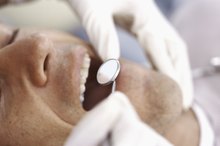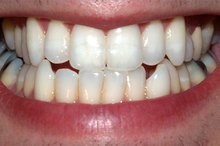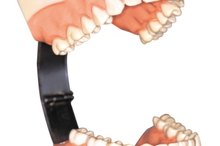Antibiotics for an Infected Tooth
According to MedlinePlus, a toothache is generally the result of a dental cavity in which the tooth begins to decay, leading to infection 123. The cause is most often attributed to poor dental hygiene, although a genetic proclivity to tooth decay can also play a role. Since the oral cavity is rife with bacteria, any opening in the tooth enamel can cause serious complications for the root and supporting bones. Physicians prescribe a variety of antibiotics to patients with tooth infections to eliminate infection-causing bacteria. Anyone who experiences persistent pain or swelling of the gums should contact a dental professional immediately.
Penicillin
According to the Merck website, penicillin is the most preferred antibiotic for oral flora 5. Penicillin functions by inhibiting the formation of bacterial walls as they proliferate, causing bacteria to weaken and die 5. A penicillin prescription for an infected tooth generally lasts for one week, although symptoms such as tissue swelling, pain and fever start to diminish after a couple of days 5. Individuals with asthma, kidney disease or a history of allergies should not use this antibiotic, Drugs.com warns 5. If symptoms persist or worsen, patients should immediately contact a dental or health care professional.
Clindamycin
Amoxicillin for Tooth Pain
Learn More
Clindamycin is an alternative antibiotic to penicillin for tooth infections, according to Merck 5. It is also used to treat a variety of bacterial infections including those of the skin, lungs and internal organs, according to MedlinePlus 12. It belongs to the lincomycin group of antibiotics and comes in capsule or liquid form with usual required dosing of three to four times per day. The length of the treatment depends on the severity of the tooth infection, although it usually does not extend past a week. MedlinePlus says that if nausea, vomiting, joint pain or thrush develops after taking this antibiotic, the patient should immediately contact a physician 12.
Amoxicillin and Clavulanate
Amoxicillin is part of the penicillin medicine group, and clavulanate belongs to the beta-lactamase inhibitors family 5. The combination of these compounds, known by several brand names, functions by killing sensitive bacteria to prevent its growth, according to MayoClinic.com 4. As an oral antibiotic, this drug helps to reduce the development of drug-resistant bacteria while remaining effective against harmful flora, according to DailyMed, a publication of the U.S. National Institutes of Health. This medication is generally safe, although diarrhea, nausea and vomiting can occur, reports Drugs.com 5.
Related Articles
References
- MedlinePlus: Toothaches
- MedlinePlus: Tooth Abscess
- Merck: Toothache and Infection
- MayoClinic.com: Penicillin
- Drugs.com: Penicillin
- UpToDate. Allergy to penicillin and related antibiotics. Updated November 11, 2019.
- Centers for Disease Control and Prevention. Evaluation and diagnosis of penicillin allergy for healthcare professionals. Updated October 31, 2017.
- Cleveland Clinic. Think you’re allergic to penicillin? Why you may be mistaken. 2016.
- Mirakian R, Leech SC, Krishna MT, et al. Management of allergy to penicillins and other beta-lactams. Clin Exp Allergy. 2015;45(2):300-27. doi:10.1111/cea.12468
- Brown KA, Khanafer N, Daneman N, Fisman DN. Meta-analysis of antibiotics and the risk of community-associated Clostridium difficile infection. Antimicrob Agents Chemother. 2013;57(5):2326-32. doi:10.1128/AAC.02176-12
- Żukiewicz-Sobczak WA, Wróblewska P, Adamczuk P, et al. Drugs as important factors causing allergies. Postepy Dermatol Alergol. 2015;32(5):388-392. doi:10.5114/pdia.2014.44021
- Adkinson NF, Mendelson LM, Ressler C, Keogh JC. Penicillin minor determinants: History and relevance for current diagnosis. Ann Allergy Asthma Immunol. 2018;121(5):537-544. doi:10.1016/j.anai.2018.09.459
- Allergy to penicillin and related antibiotics. Updated November 11, 2019.
- Fox S, Park M. Penicillin Skin Testing in the Evaluation and Management of Penicillin Allergy. Ann Allergy Asthma Immunol. 2011;106:1-7.
- Nugent JS, Quinn JM, McGrath CM, et al. Determination of the Incidence of Sensitization After Penicillin Skin Testing. Ann Allergy Asthma Immunol. 2003;90:398-403.
- Pre-Pen Package Insert. ALK-Abello.
Resources
Writer Bio
Skyler White is an avid writer and anthropologist who has written for numerous publications. As a writing professional since 2005, White's areas of interests include lifestyle, business, medicine, forensics, animals and green living. She has a Bachelor of Arts in anthropology from San Francisco State University and a Master of Science in forensic science from Pace University.









